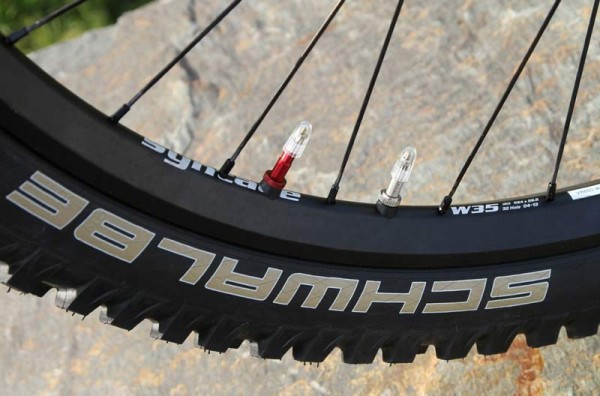Schwalbe has partnered with Syntace to offer a dual chamber mountain bike tire system. Technical details aren’t fully released yet (look for those by Eurobike this August), but the concept is fairly straightforward: Put two separate air chambers in the tire. One’s for higher pressure to keep the bead firmly seated on the rim, preventing burping and squirming. It also prevents the tire from compressing too much and hitting the rim on the ground, which could cause snake bites and pinches.
The other, on the outer edges, safely goes as low as 14psi. This lets the tire mold around the terrain for insane traction and smooth ride feel. They say it not only provides better control, but also more speed.
The concept was initially developed at both companies independent of each other, but they’ll work together to bring it to market. Schwalbe will handle the marketing and production, suggesting the bulk of the science is in the tire insert, leaving the rim to simply provide two valve holes.
The system, which should work with any conventional tire and rim, assuming there are two valve holes in those conventional rims. Expected weight is under 200g, making it perhaps more suited to downhill and enduro efforts, where gravity is providing a bit of assist.
UPDATE: Schwalbe’s PR man just rang back with a bit more info: “Basically there’s an inner tube, but it’s not really a tube, it’s a new construction process. You can pump up to 60psi into the interior chamber and as low as 12psi on the outside, though it’s a bit squirmy that low.” Essentially, it’s a second chamber that uses that high pressure to provide the above mentioned security benefits by pressing the standard tire’s bead harder into the rim’s hook, but only takes up about half the total volume. They can’t say more than that until the patents are final. In the meantime, check out Nuetech’s similar (but Schwalbe says different) system for motorcycle tires to get a visual.
Full PR below…
PRESS RELEASE: Schwalbe and Syntace are pooling their knowledge and resources to develop a revolutionary idea for mountain bikers – a dual chamber tire and wheel system.
With a dual chamber system it will be possible to ride with very low air pressures and consequently, to improve tire performance enormously. Independent of one another, Schwalbe and Syntace had the same idea, but now the two companies have decided to join forces and further develop the system together.
With low air pressure, off-road tire performance improves significantly. The tires can adapt better to the terrain and react far more sensitively; they roll more easily over uneven ground and provide more grip and control.
Riders cannot risk riding on standard MTB tires with less than 20 psi because the possibility of snake-bites is simply too great. And with the current trend toward wide wheel rims, the trail performance of the wide tires at low air pressure is improved, and has become less “spongy”, but the risk of snake-bites remains the same.
The solution is a dual chamber system.
The dual chamber system has an additional air chamber inside the tire. This inner chamber is filled with high air pressure and effectively prevents the tire hitting the edge of the rim. At the same time, the inner system also secures the tire on the rim and prevents the dreaded “burping” (a loss of air) of the tubeless system in the case of low pressure. Depending on the situation, the air pressure in the outer chamber can be reduced to 14 psi without running any risk.
Schwalbe will be responsible for the production and marketing of the dual chamber system and it is expected to be compatible with conventional tires and rims and weigh less than 200g.
All test cyclists to date have been thrilled with the new possibilities:
- At 14 psi, the tire grip is incredible. The contact surface is very large and the tires seldom, if ever, slide on loose ground. Even on the roughest terrain, the tires literally stick to the ground.
- The tire is the most sensitive cushioning element on the bike. The extra cushioning and traction because of the low air pressure leads to much better control over the bike and allows distinctly higher speeds.
- All this without the risk of snake-bites. Dented rims become a thing of the past. Significantly lighter tires can be used in even the toughest conditions. And in addition, the additional air chamber has excellent emergency running characteristics.
With the combined efforts of both Schwalbe and Syntace, the dual chamber system will reach market maturity by Eurobike 2014 with precise information regarding design, pricing and Patents pending.
